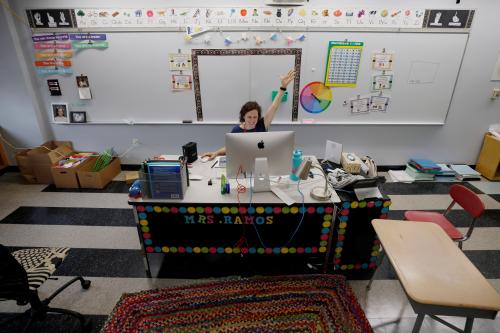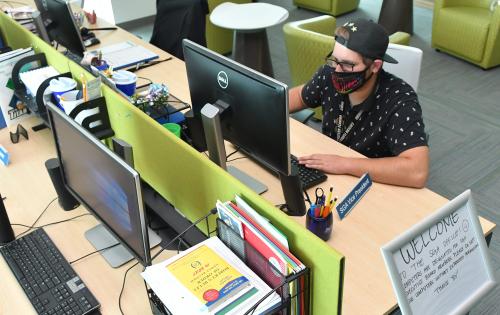Instructors are constantly on the lookout for more effective and innovative ways to teach. Over the last 18 months, this quest has become even more salient, as COVID-19 has shaken up the academic landscape and pushed teachers to experiment with new strategies for engaging their students. One innovative teaching method that may be particularly amenable to teaching during the pandemic is flipped learning. But does it work?
In this post, we discuss our new report summarizing the lessons from over 300 published studies on flipped learning. The findings suggest that, for many of us who work with students, flipped learning might be worth a try.
What is flipped learning?
Flipped learning is an increasingly popular pedagogy in secondary and higher education. Students in the flipped classroom view digitized or online lectures as pre-class homework, then spend in-class time engaged in active learning experiences such as discussions, peer teaching, presentations, projects, problem solving, computations, and group activities. In other words, this strategy “flips” the typical presentation of content, where class time is used for lectures and example problems, and homework consists of problem sets or group project work. (See Roehling, 2018, for information on how to construct and implement flipped learning.)
Flipped learning is not simply a fad. There is theoretical support that it should promote student learning. According to constructivist theory, active learning enables students to create their own knowledge by building upon pre-existing cognitive frameworks, resulting in a deeper level of learning than occurs in more passive learning settings. Another theoretical advantage of flipped learning is that it allows students to incorporate foundational information into their long-term memory prior to class. This lightens the cognitive load during class, so that students can form new and deeper connections and develop more complex ideas. Finally, classroom activities in the flipped model can be intentionally designed to teach students valuable intra- and interpersonal skills.
Since 2012, the research literature on the effectiveness of flipped learning has grown exponentially. However, because these studies were conducted in many different contexts and published across a wide range of disciplines, a clear picture of whether and when flipped classrooms outperform their traditional lecture-based counterparts has been difficult to assemble.
To address this issue, we conducted a comprehensive meta-analysis of flipped pedagogies; this review focused specifically on higher education contexts. For our meta-analysis, we combined data from 317 studies (51,437 participants) that compared the effectiveness of flipped and lecture-based courses taught by the same instructor.
We assembled all of these studies to examine the efficacy of flipped versus lecture-based learning for fostering a variety of outcomes in higher education. Specifically, we examined outcomes falling into three broad categories:
- Academics, including exams and assignments measuring foundational knowledge, higher-order thinking, and applied/professional skills;
- Intra-/interpersonal aptitudes, including student engagement and identification with the course or discipline, metacognitive skills, and interpersonal skills; and
- Satisfaction with the course and instruction as reported by students.
We also explored the extent to which factors related to educational context (e.g., discipline, geographic location) and course design (e.g., the use of quizzes to motivate pre-class preparation) may shape the effectiveness of flipped learning. Below, we outline some of the key takeaways of our meta-analytic synthesis.
Is flipped learning more effective than lecture-based learning?
Yes, it certainly can be. Students in flipped classrooms performed better than those in traditionally taught classes across all of the academic outcomes we examined. In addition to confirming that flipped learning has a positive impact on foundational knowledge (the most common outcome in prior reviews of the research), we found that flipped pedagogies had a modest positive effect on higher-order thinking. Flipped learning was particularly effective at helping students learn professional and academic skills.
Importantly, we also found that flipped learning is superior to lecture-based learning for fostering all intra-/interpersonal outcomes examined, including enhancing students’ interpersonal skills, improving their engagement with the content, and developing their metacognitive abilities like time management and learning strategies.
In which educational settings is flipped learning most effective?
Flipped learning was shown to be more effective than lecture-based learning across most disciplines. However, we found that flipped pedagogies produced the greatest academic and intra-/interpersonal benefits in language, technology, and health-science courses. Flipped learning may be a particularly good fit for these skills-based courses, because class time can be spent practicing and mastering these skills. Mathematics and engineering courses, on the other hand, demonstrated the smallest gains when implementing flipped pedagogies.
The relative benefits of flipped learning also vary based upon geographic location across the globe. Whereas flipped courses outperformed lecture courses in all of the regions that were adequately represented in our meta-analysis, flipped classes in Middle Eastern and Asian countries produced greater academic and intra-/interpersonal gains than flipped courses implemented in Europe, North America, or Australia. These findings suggest that flipped learning may have the greatest impact in courses that, in the absence of flipped learning, adhere more strictly to a lecture-format, as is often the case in the Middle East and Asia. However, we might expect benefits in any context where active learning is used less regularly.
How can you design an effective flipped course?
When designing a flipped course, the conventional wisdom has been that instructors should use pre-class quizzes and assignments to ensure that students are prepared to participate in and benefit from the flipped class period. Surprisingly, we found little support for this in our analysis. While using in-class quizzes did not affect learning outcomes, using pre-class quizzes and assignments to hold students accountable actually produced lower academic gains. It’s unclear why this is the case. It may be that pre-class assignments shift the focus of student preparation; rather than striving to understand the course material, students focus on doing well on the quiz. This suggests that, to hold students accountable for pre-class preparation, instructors should consider using in-class quizzes and assessments rather than pre-class assignments.
We also found that more isn’t always better. Compared to courses where all (or nearly all) class sessions followed the flipped model (“fully flipped”), courses that combined flipped and lecture-based approaches (“partially flipped”) tended to produce better academic outcomes. Given the time and skill required to design effective flipped class sessions, partially flipped courses may be easier for instructors to implement successfully, particularly when they are new to the pedagogy. Partially flipped courses also give instructors the flexibility to flip content that lends itself best to the model, while saving more complex or foundational topics for in-class instruction.
What about student satisfaction?
Another reason to consider flipped learning is student satisfaction. We found that students in flipped classrooms reported greater course satisfaction than those in lecture-based courses. The size of this overall effect was fairly small, so flipping the classroom is not a silver bullet for instantly boosting course evaluations. But in no context did flipping the classroom hurt course ratings, and in some settings, including mathematics courses and courses taught in Asia and Europe, we observed more pronounced increases in student satisfaction.
Adopting a new pedagogy can be daunting, and a significant barrier to converting a course to a flipped format is the substantial time commitment involved in creating digitized lectures. However, during the 2020-2021 pandemic surges, many instructors were encouraged (if not forced) to find new ways of teaching, leading many to record their lectures or create other supplementary digital content. For instructors who have now created such digital content, this could be a great time to experiment with flipped learning.






Commentary
Flipped learning: What is it, and when is it effective?
September 28, 2021